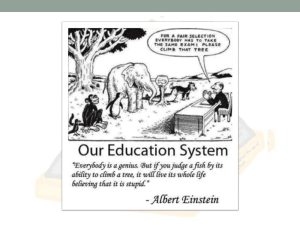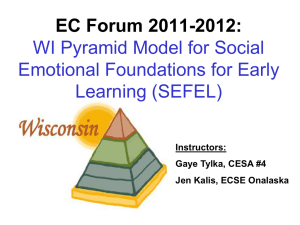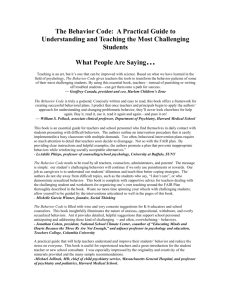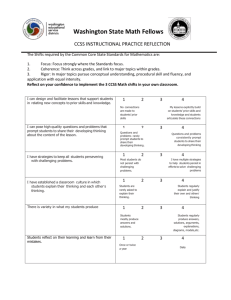Module 4 - The Institute for Innovation & Implementation
advertisement
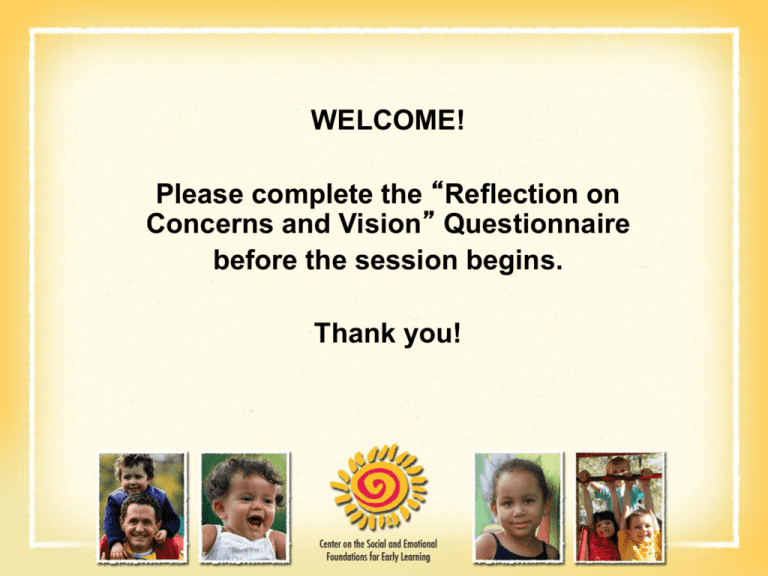
WELCOME! Please complete the “Reflection on Concerns and Vision” Questionnaire before the session begins. Thank you! Leadership Strategies for Supporting Children’s Social Emotional Development and Addressing Challenging Behavior Module 4 Purpose of Workshop • Provide time to reflect and focus • Present an evidence based framework • Provide evidence based leadership tools • Provide resources on evidence based practices Learner Objectives Participants will: • Describe an evidence based framework for addressing social emotional development and challenging behavior. • Identify strategies to address common barriers to evidence based practices. • Identify effective leadership strategies including collaborative planning, program-wide planning, and professional development. • Apply collaborative action planning strategies for improving children’s social emotional and behavioral outcomes. Agenda • • • • • • • • • Introduction to Topic Evidence Based Practices and Resources The Pyramid Approach Inventory of Practices and Activity What is Challenging Behavior? Role of Program Administrators Evidence Based Leadership Strategies Three Levels of Change Summary Introductory Activity Which of the following do you think is the most significant barrier to effectively addressing social emotional development and challenging behavior in young children? 1. Knowledge and skills of professionals and parents 2. Collaboration and coordination 3. Beliefs and attitudes 4. Other * Introduce yourself: name and role, agency, etc. Some Sobering Facts 7 An estimated 9 to 13% of American children and adolescents between ages 9 to 17 have serious diagnosable emotional or behavioral health disorders resulting in substantial to extreme impairment. (Friedman, 2002) 8 Students with SED miss more days of school than do students in all other disability categories (U.S. Department of Education, 1994) More than half of students with SED drop out of grades 9-12, the highest rate for all disability categories. (U.S. Department of Education, 2002) Of those students with SED who drop out of school, 73% are arrested within five years of leaving school (Jay & Padilla, 1987) 9 Children who are identified as hard to manage at ages 3 and 4 have a high probability (50:50) of continuing to have difficulties into adolescence (Campbell & Ewing, 1990; Egeland et al., 1990; Fischer, Rolf, Hasazi, & Cummings, 1984). 10 11 Early appearing aggressive behaviors are the best predictor of juvenile gang membership and violence. (Reid, 1993) 12 When aggressive and antisocial behavior has persisted to age 9, further intervention has a poor chance of success. (Dodge, 1993) 13 Of the young children who show early signs of challenging behavior, it has been estimated that fewer than 10% receive services for these difficulties. (Kazdin & Kendall, 1998) 14 Preschool children are three times more likely to be “expelled” then children in grades K-12 (Gilliam, 2005) 15 There are evidence based practices that are effective in changing this developmental trajectory…the problem is not what to do, but rests in where and how we can support children and help families access services 16 Evidence Based Practice: A Definition Evidence based practice refers to the use of interventions and supports that have research documenting their effectiveness. The identification of evidence based practices promotes the use of approaches that are linked to positive outcomes for children and families. Practices that are considered evidence based are ones that have been demonstrated as effective within multiple research studies that document similar outcomes. Available at http://www.evidencebasedpractices.org/centerscope Evidence Based Practice: A Definition Dunst, Trivette, and Cutspec (2002) offer the following operational definition of evidence based practice that is particularly meaningful for the field of early education and intervention. Evidence based practices are “Practices that are informed by research, in which the characteristics and consequences of environmental variables are empirically established and the relationship directly informs what a practitioner can do to produce a desired outcome.” Dunst, C. J., Trivette, C. M., & Cutspec, P. A. (2002). Toward an operational definition of evidence-based practice. Centerscope, 1(1), 1-10. Available at http://www.evidencebasedpractices.org/centerscope . What Does “Evidence Based Practice” Mean? • Evidence: the data on which a conclusion or judgment may be based (Webster’s II New College Dictionary, 1995) • Proven to work What Does “Evidence Based Practice” Mean? • Levels of evidence or levels of confidence that the practice will have the desired outcome: – – – – – – Peer-reviewed published research findings Published synthesis of research Multi-authored position papers Government reports Consensus/values Opinion, etc. (high) (low) Effective Practices • Changing adult behavior and expectations • Promoting overall high program quality • Promoting social skills, preventing & addressing challenging behavior (pyramid model) • Teaching parents effective techniques • Using empirically validated interventions which include: – Comprehensive strategies e.g., adaptations to environment and activities, learning class rules, roleplaying alternative behaviors, arranging for peer models & reinforcing desirable behaviors – Individualizing approaches – Positive programming, e.g., Positive Behavior Support (PBS) – Team-based and multidisciplinary approaches – Using data-based strategies and decision making What Positive Social Emotional Outcomes Can Be Expected from Evidence Based Practices? • Decrease in: – Withdrawal, aggression, noncompliance, and disruption – Teen pregnancy, juvenile delinquency, and special education placement • Increase in: – Positive peer relationships including understanding of friendship, cooperation, and sharing – Self-control, self-monitoring, self-correction, and improved social emotional health – Academic success Evidence Based Practices: Resources • Evidence based practices in: • services • systems/programs • service utilization • The Center for Evidence Based Practices: Young Children with Challenging Behavior (CEBP) Research Syntheses, PowerPoint, “Recommended Practices” (www.challengingbehavior.org) • Center on the Social and Emotional Foundations for Early Learning (CSEFEL) “What Works Briefs,” “modules,” Inventory of Practices” (www.csefel.uiuc.edu) Challenges to Effective Practices Focus groups with T/TA providers, state policy makers, program personnel, and families identified Four Categories of Challenges: • Lack of knowledge/skill • Beliefs/Attitudes • Lack of collaboration within programs, with families, and within communities • Lack of adequate fiscal resources and procedures An Evidence Based Framework: The Pyramid Approach • PROMOTION • PREVENTION • INTERVENTION Teaching Pyramid Children with persistent challenges Children at-risk Intensive Individualized Interventions Positive Behavior Support Social Emotional Teaching Strategies Designing Supportive Environments All children Building Positive Relationships Social Skills Curricula High quality Early Education Inventory of Practices & Action Plan Designed to be used by individuals and/or teams to identify training needs related to four areas: 1. 2. 3. 4. Building Positive Relationships Designing Supportive Environments Social Emotional Teaching Strategies Individualized Intensive Interventions Inventory of Practices for Promoting Social Competence • Best used in a manner to generate reflection and discussion • Allows for development of an Action Plan that: – Targets skills for training – Identifies strategies to support the team in implementing the new practices – Identifies resources and supports needed to complete the activities or strategies Activity • As a group, discuss a set of practices from the Inventory’s action plan. • What can you, as a leader, do in your work with direct service personnel and families that would lead to the use of these practices? Note these under “Supports and Resources” • Have one member of your team be prepared to report to the entire group: 1) the practices and what they mean, 2) the level of the “Teaching Pyramid” they relate to, and 3) the leadership supports and resources needed. What is Meant by Challenging Behaviors? • They are defined by adult within the context of his/her culture. • Sometimes the behaviors decrease with age and use of appropriate guidance strategies. • Sometimes they are developmentally expected behaviors. DEC Concept Paper on Identification of and Intervention with Challenging Behavior, 1999 What Are Challenging Behaviors Needing Intensive Individualized Intervention? Any repeated pattern or perception of behavior that interferes with or is at risk of interfering with optimal learning or engagement in prosocial interactions with peers and adults that is persistent or unresponsive to evidence based approaches. Challenging behavior is thus defined on the basis of its effects. Center for Evidence-Based Practices: Young Children with Challenging Behavior, www.challengingbehavior.org Examples of Challenging Behaviors • • • • Physical and Verbal Aggression Noncompliance/Defiance Self-Injury Disruptive vocal/motor responses (screaming, stereotypic behavior) • Destruction of property • Withdrawal Center for Evidence-Based Practices: Young Children with Challenging Behavior, www.challengingbehavior.org Examples of Challenging Behaviors For Infants and Toddlers • • • • Attachment difficulties Sleeping/eating difficulties Excessive crying Difficulty in soothing Center for Evidence-Based Practices: Young Children with Challenging Behavior, www.challengingbehavior.org Challenging Behaviors • Behaviors may: – – – – Result in self-injury or injury to others Cause damage to the physical environment Interfere with the acquisition of new skills And/or socially isolate the child • Serious behaviors seldom resolve themselves without systematic intervention – Usually children progress through a predictable course of ever-escalating challenging behaviors DEC Concept Paper on Identification of and Intervention with Challenging Behavior, 1999 Prevalence Pyramid 1-10% Children with Persistent Challenges Focused Interventions 5-15% Children At-Risk Intervention and Support All Children Universal Interventions The Promise, The Challenge • The Promise: – We have evidence based practices • • • • • Earlier is better Support for parents matters High-quality environments are key A comprehensive approach is necessary Behavior consultation makes a difference – Parents and teachers can implement the practices in natural settings The Promise, The Challenge • The Challenge – How do we ensure that effective practices are accessible to all children and families? – How do we build systems within programs and communities such that teachers and families have the support they need to implement the practices? Link between Program Administration and Child & Family Outcomes “…an adequate infrastructure increases the likelihood that recommended practices will be used to deliver services and supports to young children and their families…” “…When quality [evidence based] practices are used consistently it is more likely that children and their families will experience positive outcomes.” Link between Program Administration and Child & Family Outcomes (Cont.) “…The interdependent relationships between structure, services, supports, and outcomes are consistent with ecological theories of development….these theories suggest that the child’s development is influenced not only by the family, neighborhood, subculture, and community, but by the systems of services and supports that serve them as well.” -- Harbin & Salisbury, in Sandall, McLean & Smith, 2000 Evidence Based “Direct Services” Require: Evidence Based Direct Services Staff Development & Support Evidence Based “Indirect Supports” (policies, vision, support, etc.) Leaders Must Be Well Trained Program administrators should have training in early childhood education, early intervention, child development, or early childhood special education; and administration, supervision. Smith, Barbara J. (2000). Administrators essentials, in S. Sandall, M. McLean & B. Smith (Eds.), DEC Recommended Practices in Early Intervention/Early Childhood Special Education. www.dec-sped.org; NAEYC accreditation standards and performance criterion (2004). Leadership and Management, www.naeyc.org. 5 Practices of Exemplary Leadership • Model the way • Inspire a shared vision • Challenge the process • Enable others to act • Encourage the heart Kouzes & Posner (2003). The Leadership Challenge. San Francisco: Jossey-Bass Evidence Based Practices: Role of Program Leadership • Provide Leadership and Vision • Monitor Compliance with Requirements • Ensure Child Well-being/Progress • Ensure Appropriate Deployment of Resources/Budget • Support Staff Knowledge and Skills • Provide Collaborative Leadership and Planning • Others? 3 Evidence Based Strategies • Leadership & Vision • Collaborative Leadership and Planning • Supporting Personnel Knowledge & Skills Leadership/Vision • Leaders model developmentally and culturally appropriate expectations for children’s behavior. • Leaders help staff reflect on the relationship of their behavior and children’s behavior. • Leaders set a vision that expectations and practices are evidence based. • Leaders view all stakeholders (program personnel, families, community) as partners. • Other? DEC Recommended Practices: Creating Policies and Procedures that Support \ Recommended Practices in Early Childhood There is a link between program quality and child outcomes. Therefore, programs that employ best practices will positively impact the outcomes of children and families they serve. 1. Ensure that leaders and staff have knowledge, training, and credentials. 2. Ensure that families are partners. 3. Promote the use of standards (foundations). 4. Promote interagency and interdisciplinary collaboration. 5. Plan for program evaluation and systems changes. Activity Working with the DEC Administrator Essentials Checklist Collaborative Leadership, Planning and Decision Making: A Model 1. Make the commitment and provide leadership. 2.Share decision making with stakeholders (staff, families, other agencies, consultants, etc.) to build commitment: create a decision making stakeholder team. Steps for Collaborative Planning (Cont.) 3. Build a vision with the Stakeholder Team related to supporting children’s social emotional development and addressing challenging behavior through evidence based practices. 4. Identify challenges to the vision with the Team (beliefs, policies, systems, knowledge/skills). 5. Engage in action planning with the Team to address the challenges. Steps for Collaborative Planning (Cont.) 6. Cultivate leadership and risk taking. 7. Continue to build and expand the commitment through incentives, recognition, T/TA, fiscal, and other resources. 8. Continuously evaluate the process and the outcomes of the collaboration and action planning. Action Planning: Identify Challenges • Follow steps of Collaborative Planning Model (commitment, team, vision, etc.). • Develop Team Definitions and Philosophy (Evidence based, Promotion, Prevention, Intervention, etc.). • Brainstorm the Statement: “We’d like to use evidence based practices to promote social emotional development and address challenging behavior, but… Action Planning: Identify Challenges (Cont.) • List the challenges that emerge from brainstorming. • Transfer to Action Plan Form. • If a challenge is believed to be a written policy or procedure…GET A COPY! Don’t believe it ‘til you see it! Action Planning: Identify Strategies (Objectives) • Establish criteria for trying possible strategies (ease, timelines, durability, etc.). • For each challenge, brainstorm this statement: “We could remedy this challenge by...” • Select strategies from the brainstorming. • Transfer to Action Plan Form. ACTION PLANNING FORM Team Members Challenge to be addressed:_______________________________________________________________________ Objective/ Strategy Action Steps to be Taken Date to be completed & Persons Responsible Resources & Supports Needed Date Accomplished Impact Date: _________________________ Status: _______________________________________________________________________ Date: _________________________ Status: _______________________________________________________________________ Date: _________________________ Status: _______________________________________________________________________ Date: _________________________ Status: _______________________________________________________________________ Date: _________________________ Status: _______________________________________________________________________ Date: _________________________ Status: _______________________________________________________________________ Knowledge and Skills: Professional Development Experiences designed to develop new knowledge, skills, and behaviors that are expected to be applied immediately on the job Purpose of Professional Development: Change behavior in the work environment Methods for Professional Development • Direct in-service or pre-service training • Use of professional materials – (e.g., books, journals) • Coaching • Supervision • Evaluation and recognition What Is Transfer of Learning? Instructional Experiences Transfer of Learning Applied at Work Effective and continuing application of knowledge, skills, and behaviors gained through instructional experiences by staff to their job over a period of time Research Says: “While American industries annually spend up to $100 billion on training and development, not more than 10% of these expenditures actually result in transfer to the job.” Transfer of Training: A Review and Directions for Future Research in Personnel Psychology, 1988, 31, pg. 63 Transfer Strategies • • • • • Match professional development to needs. Communicate importance and expectations. Help staff prepare for training/instruction. Support application of new knowledge/skills. Recognize staff for applying new knowledge/skills. Kentucky Training into Practice Project, Director’s Seminar, 2003 Match Professional Development to Need • Identify needs • • • • • Conduct staff needs assessment to identify opportunities for growth. Respond to needs assessment and pre-instruction activities (director/trainee). Help instructor design “real-life work-related” scenarios, examples, etc. Determine post activity outcomes that need to be measured. How can the Inventory of Practices be used to identify need? Match Professional Development to Need Ensure a link between practices/methods being promoted and supportive evidence. Determine the link between program philosophy and practice being promoted. Select instruction based on gaps in knowledge base and competency levels. Offer staff choices of relevant instruction Support peer-to-peer learning (i.e., send co-workers to training together). Communicate • Expectations related to the application of new knowledge/skills during and through: Interviews Job descriptions New/old staff orientation Professional development plans • Build transfer of learning into performance standards. Help Staff Prepare for Learning Experiences • Encourage staff to: Set professional development goals. Explore content beforehand (is it based on evidence of effectiveness?). Complete pre-training/instruction activities. Identify current situation related to instruction that needs a solution. Identify a follow-up activity. • Conduct a pre-training/instruction meeting. Support Application of New Knowledge/Skills • Conduct post-instructional meetings. • Help staff develop an individual action plan and monitor/supervise progress. • Modify the work environment to support application. • Provide opportunities to practice new skills. Support Application of New Knowledge/Skills (Cont.) • Provide resources and supervision needed for application. • Schedule briefings for co-workers. • Provide coach/mentor and/or establish peer/coaching program. The Coaching Process Planning Conference Observation Debriefing Conference Teaching Performance Reflection Time Recognize Staff for Applying New Knowledge/Skills Acknowledge and recognize successes: • Hats-off bulletin board • Special certificates • “Pats on the back” notes Create incentives: • Promotions • Pay increases • Rewards Four Critical Levels of Evaluation Reaction – What was the general reaction to the professional development activity Learning – What did the staff member learn as a result of the event Behavior Change – Did the activity result in a change in behavior within the classroom or program Results – Did the activity result in positive outcomes for: • the program • the children • the families Gusky, T. R. (2002) Does it make a difference? Evaluating professional development. Educational Review, vol.. 59, no. 6, pp. 45-51, March; Kirkpatrick, D. (2000). Techniques for evaluation training programs. In John A. Woods and James W. Cortada (Eds.). The 2000 ASTD training and performance yearbook, pp. 3-10, New York: McGraw-Hill. How Can You Reward Employees? • Informal rewards – – – – – – – No-cost recognitions Low-cost recognitions Activities Public recognitions/Social rewards Communication Time-off Cash/cash substitutes/gift certificates Nelson, Bob (1994). 1001 Ways to Reward Employees. NY: Workman Publishing Co. How Can You Reward Employees? • Informal rewards, continued – Merchandise/Apparel/Food – Recognition items/Trophies/Plaques – Fun/Celebrations • Awards for specific achievements and activities – Outstanding employee awards – Quality awards – Employee suggestion awards Nelson, Bob (1994). 1001 Ways to Reward Employees. NY: Workman Publishing Co. How Can You Reward Employees? • Awards for specific achievements and activities, continued – Customer service awards – Group/team awards – Attendance and safety awards • Formal awards – Contests – Field trips/special events/travel – Education/personal growth/visibility Nelson, Bob (1994). 1001 Ways to Reward Employees. NY: Workman Publishing Co. Individual Growth Plan AREA GOAL Activities Evaluation Resources Needed Table Activity For the challenge assigned to your table: • Identify a strategy for solving the challenge (see sample in “Participant’s Workbook”). • Name team members for collaborative planning. • Draft an action plan (action plans are in the workbook). Three Levels of Promoting Social Emotional Development and Addressing Challenging Behavior: • Child level • Program or Center-wide level • Community or System level Teaching Pyramid Children with persistent challenges Children at-risk Intensive Individualized Interventions Positive Behavior Support Social Emotional Teaching Strategies Designing Supportive Environments All children Building Positive Relationships Social Skills Curricula High quality Early Education Child Level • Create team of administrators, families, direct services, staff members, and consultants. • Commit to evidence based promotion, prevention, and intervention practices in class or home-visiting services. • Use the teaching pyramid. Program- or Center-wide Level • What is a program-wide model for preventing/addressing challenging behavior? • Builds on the Teaching Pyramid by designing intervention from the whole (universal) program to the individual child Program- or Center-wide Level •Uses collaboration to ensure: – Administrative support and buy-in – Buy-in from staff – Family involvement Dunlap, Glen. Fox, Lisa. Hemmeter, Mary Louise.(2004) Program Wide Approaches for Addressing Children’s Challenging Behavior. National Training Institute presentation, Clearwater Beach, FL. Program- or Center-wide Level (Cont.) • Critical Elements: – Identification of program-wide vision and expectations that are developmentally appropriate – Strategies for embedding the pyramid approach (promotion, prevention, intervention) throughout the program – Curriculum approaches that promote vision and expectations and acknowledge children’s achievement of the expectations Program- or Center-wide Level (Cont.) • Critical Elements: – Strategies for responding to challenging behavior – Team based, individualized approach for addressing ongoing challenging behavior – Professional development plans – Strategies for supporting teachers – Process for monitoring outcomes- data collection Dunlap, Glen. Fox, Lisa. Hemmeter, Mary Louise. (2004) Program Wide Approaches for Addressing Children’s Challenging Behavior, presentation, National Training Institute, Clearwater Beach, Fla. Example: SEK-CAP Head Start • Rural program in southeast Kansas • Covers over 7,000 square miles in 12 counties • Serves 768 children and families • Employs 174 staff in the Early Childhood Services • 14 centers, 17 classrooms, 25 home visitors, and19 child care partners Why They Chose Program-wide Adoption Background: Even with training in behavior management techniques, Head Start staff reported: • leaving work in tears • inability to deal with all children • high levels of stress and burnout • looking to outside “experts” to solve problems in the classroom Administrative Support for Program-Wide Adoption Leadership Commitment Resource Deployment Data-based, Intentional Data-based, Planning Intentional Planning Shared Decision Sharedmaking, Decision making, Collaboration Collaboration Staff Development Leadership • Leader as resource & support to staff • Leader as listener and data collector • Shared decision making: Build a team and shared vision; foster a climate of risk-taking • I.D. consultant re: evidence based practices • Develop collaborative plan • Deploy resources/$ as dictated by plan Resource Deployment/Budget • Resources re-focused to support promotion and prevention, e.g., MH consultants assisted with promotion & prevention not just intervention • Resources for staff development & support; transfer of knowledge activities; and continuing education • Resources were targeted for data collection, management, consultants for ongoing analysis and evaluation Resource Deployment/Budget • Resources were used for consultants to i.d. evidence based practices, training, facilitation • Resources and time were allocated for acknowledging staff work • Resources for staff well-being, benefits • Resources were allocated for teaming • Satisfied, trained staff = less turnover, better outcomes Staff Development & Support • Embed Pyramid throughout the program • Staff/interviewees learn expectations • Initial training provided Staff Development & Support • Following initial training, each center worked as a team to identify needs • Met with supervisory staff person to develop an Implementation Plan • Program, staff, and site professional development plans Staff Development & Support Attend to transfer of knowledge by: • Mentoring: staff and sites can mentor based on assessed strengths • Acknowledging work • Employing “substitutes” • Continuing education support Planning & Accountability Ongoing evaluation and Data-based planning meetings. Data collected through: • Classroom Observations • Staff Interviews & Satisfaction Surveys • Referral Data • Staff self-assessments and development plans Planning & Accountability • Build a data management system • Child and family outcome data • All data used by Team for short and long range planning and evaluation • Consultant hired to analyze data and develop reports Collaboration • Collaboration! Takes time, effort, and patience. • With families: Partner from beginning. What are their objectives? What does the child like? Policy Council approved initiative. • With staff: Core and staff teams collaborate in planning and decision making; home-visitor program is transdisciplinary. • With community: Share training opportunities; collaborate with higher education (courses, field placements); ensure child care and other community programs at table when planning for a child. • Challenges: Philosophies, beliefs, turf, and finances. Program-wide Adoption: Outcomes • Staff view themselves as having the skills to better support children in classrooms. • Staff look to each other as sources of additional information and support. • Staff can demonstrate the fundamental elements in their classrooms. Outcomes • A culture of support is created throughout the program. • Staff become intentional and purposeful in interactions with children in order to build on their strengths. • Staff turn over is reduced; staff satisfaction is increased. Outcomes • Staff ask for fewer suggestions from mental health professionals. • The number of children receiving individual counseling from psychologists decreased. • The number of children identified as having challenging behavior and referred for mental health services decreased. • Program spends less time and resources on intervention level and more on prevention level of the Pyramid. Community or System-wide • Systems must provide range or continuum of service: promotion to prevention to intervention. • Systems must provide a comprehensive array of services. • Services must be individualized. Smith, B. & Fox, L., Synthesis of Evidence Related to Systems of Services, Center for Evidence-Based Practice: Young Children with Challenging Behavior, www.challengingbehavior.org Community or System-wide (Cont). • Systems should be family-centered and include both child-focused services and family supports. • Personnel need resources and working conditions to provide evidence based services: adequate funding, caseloads, collaborative arrangements, professional development opportunities, wages, and benefits, etc. Community or System-wide (Cont). The “systems of care” concept used in mental health offers promising guidelines. “System of care”: The weaving together of multiple existing services or programs into a cohesive, collaborative system that reduces overlap, fills gaps, and addresses transition issues for children moving from one service to another or needing to access multiple services. Community/System Pyramid Children with Delays & Persistent Challenges (Family-Centered Intervention Focused on Targeted Outcomes) Children At-Risk (Parenting Support and Education, Health Care, Home Visiting, High Quality Early Care, Family Supports and Services, Screening and Assessment, Service Coordination and Case Management, Mental Health Consultation, etc.) All Children (Nurturing Relationships, Health Care, Parent Education, Screening, High Quality Early Care, etc.) Resources for Evidence Based Practices • Center on the Social Emotional Foundations for Early Learning (CSEFEL) www.csefel.uiuc.edu • Center for Evidence-Based Practices: Young Children with Challenging Behavior www.challengingbehavior.org Take-Home Activity • Write one idea for using Collaborative Action Planning: 1. For a child-level issue 2. For program-wide planning, and 3. For a systems/community-level issue • Write: who should be on the team, how you might get started, and a few objectives and activities. BE THE CHANGE YOU WISH TO SEE Mahatma Gandhi

